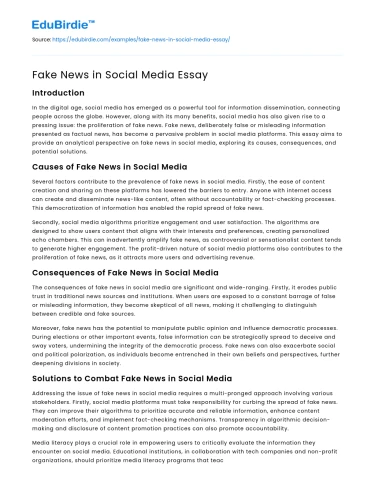Introduction
In the digital age, social media has emerged as a powerful tool for information dissemination, connecting people across the globe. However, along with its many benefits, social media has also given rise to a pressing issue: the proliferation of fake news. Fake news, deliberately false or misleading information presented as factual news, has become a pervasive problem in social media platforms. This essay aims to provide an analytical perspective on fake news in social media, exploring its causes, consequences, and potential solutions.
Causes of Fake News in Social Media
Several factors contribute to the prevalence of fake news in social media. Firstly, the ease of content creation and sharing on these platforms has lowered the barriers to entry. Anyone with internet access can create and disseminate news-like content, often without accountability or fact-checking processes. This democratization of information has enabled the rapid spread of fake news.
Save your time!
We can take care of your essay
- Proper editing and formatting
- Free revision, title page, and bibliography
- Flexible prices and money-back guarantee
Secondly, social media algorithms prioritize engagement and user satisfaction. The algorithms are designed to show users content that aligns with their interests and preferences, creating personalized echo chambers. This can inadvertently amplify fake news, as controversial or sensationalist content tends to generate higher engagement. The profit-driven nature of social media platforms also contributes to the proliferation of fake news, as it attracts more users and advertising revenue.
Consequences of Fake News in Social Media
The consequences of fake news in social media are significant and wide-ranging. Firstly, it erodes public trust in traditional news sources and institutions. When users are exposed to a constant barrage of false or misleading information, they become skeptical of all news, making it challenging to distinguish between credible and fake sources.
Moreover, fake news has the potential to manipulate public opinion and influence democratic processes. During elections or other important events, false information can be strategically spread to deceive and sway voters, undermining the integrity of the democratic process. Fake news can also exacerbate social and political polarization, as individuals become entrenched in their own beliefs and perspectives, further deepening divisions in society.
Solutions to Combat Fake News in Social Media
Addressing the issue of fake news in social media requires a multi-pronged approach involving various stakeholders. Firstly, social media platforms must take responsibility for curbing the spread of fake news. They can improve their algorithms to prioritize accurate and reliable information, enhance content moderation efforts, and implement fact-checking mechanisms. Transparency in algorithmic decision-making and disclosure of content promotion practices can also promote accountability.
Media literacy plays a crucial role in empowering users to critically evaluate the information they encounter on social media. Educational institutions, in collaboration with tech companies and non-profit organizations, should prioritize media literacy programs that teach individuals how to identify fake news, verify sources, and navigate the complexities of social media effectively.
Collaboration between social media platforms, fact-checking organizations, and traditional media outlets is vital. By working together, they can develop shared standards for content verification, establish fact-checking partnerships, and promote reliable sources of information. Fact-checking labels and warnings can be applied to misleading content, enabling users to make informed decisions about the credibility of the information they encounter.
Government regulation and policy interventions may also be necessary to address the challenges posed by fake news in social media. Legislation can encourage transparency in social media platforms' content algorithms, require disclosure of funding sources for political advertisements, and impose consequences for spreading deliberate misinformation. However, care must be taken to balance the regulation with the need to protect free speech and avoid undue censorship.
Conclusion
The prevalence of fake news in social media poses significant challenges in the information age. Understanding its causes, consequences, and potential solutions is crucial for mitigating its impact on society. By holding social media platforms accountable, promoting media literacy, fostering collaboration between stakeholders, and implementing appropriate regulations, we can strive to create a digital landscape where accurate and reliable information prevails, fostering an informed and resilient society.






 Stuck on your essay?
Stuck on your essay?

